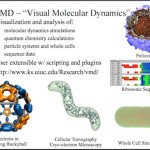There are two main categories or uses where rendering on the Intel Xeon Phi processors should be investigated. The first is what could be called “Professional rendering” and the second, “Scientific visualization.” “Software based visualization, whether for photo-realistic rendering or scientific visualization can be accelerated with a software only approach. This allows for new algorithms to be implemented faster than waiting for the next generation of hardware systems to appear. As the number of computing elements increases, performance can increase as well.”
Visualizing Biomolecular Complexes on x86 and KNL Platforms: Integrating VMD and OSPRay
John Stone from the University of Illinois presented this talk at the Intel HPC Developer Conference at SC15. “VMD is designed for modeling, visualization, and analysis of biological systems such as proteins, nucleic acids, lipid bilayer assemblies, etc. It may be used to view more general molecules, as VMD can read standard Protein Data Bank (PDB) files and display the contained structure.”





